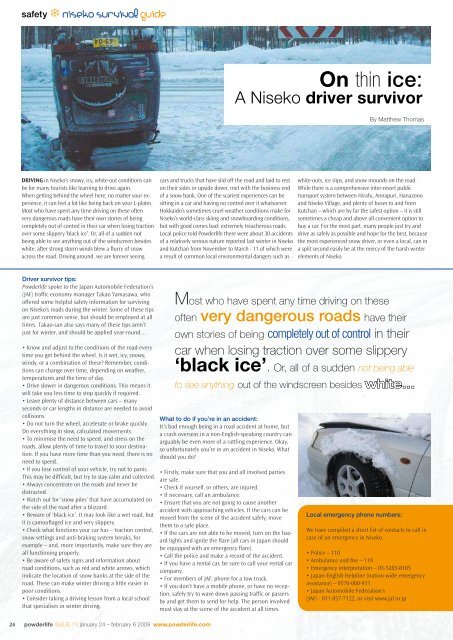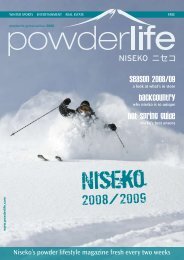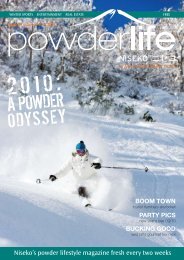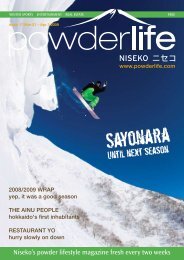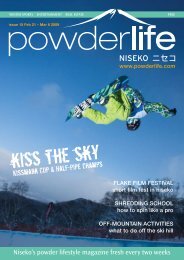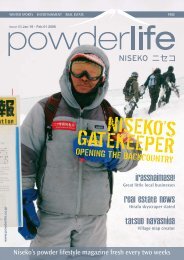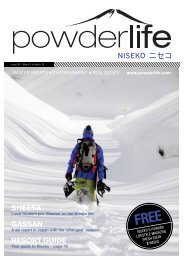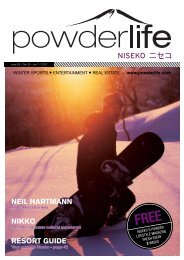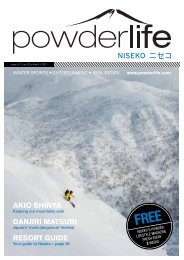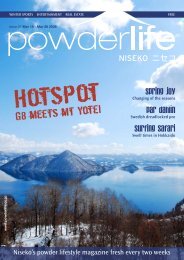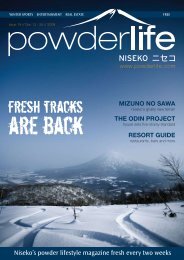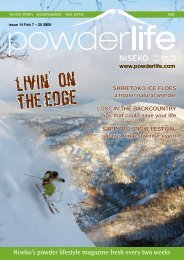not being able - Powderlife Niseko
not being able - Powderlife Niseko
not being able - Powderlife Niseko
You also want an ePaper? Increase the reach of your titles
YUMPU automatically turns print PDFs into web optimized ePapers that Google loves.
safety T niseko survival guide<br />
DRIVING in <strong>Niseko</strong>’s snowy, icy, white-out conditions can<br />
be for many tourists like learning to drive again.<br />
When getting behind the wheel here, no matter your experience,<br />
it can feel a lot like <strong>being</strong> back on your L-plates.<br />
Most who have spent any time driving on these often<br />
very dangerous roads have their own stories of <strong>being</strong><br />
completely out of control in their car when losing traction<br />
over some slippery ‘black ice’. Or, all of a sudden <strong>not</strong><br />
<strong>being</strong> <strong>able</strong> to see anything out of the windscreen besides<br />
white, after strong storm winds blew a flurry of snow<br />
across the road. Driving around, we are forever seeing<br />
Driver survivor tips:<br />
<strong>Powderlife</strong> spoke to the Japan Automobile Federation’s<br />
(JAF) traffic economy manager Takao Yamasawa, who<br />
offered some helpful safety information for surviving<br />
on <strong>Niseko</strong>’s roads during the winter. Some of these tips<br />
are just common sense, but should be employed at all<br />
times. Takao-san also says many of these tips aren’t<br />
just for winter, and should be applied year-round…<br />
• Know and adjust to the conditions of the road every<br />
time you get behind the wheel. Is it wet, icy, snowy,<br />
windy, or a combination of these? Remember, conditions<br />
can change over time, depending on weather,<br />
temperatures and the time of day.<br />
• Drive slower in dangerous conditions. This means it<br />
will take you less time to stop quickly if required.<br />
• Leave plenty of distance between cars – many<br />
seconds or car lengths in distance are needed to avoid<br />
collisions.<br />
• Do <strong>not</strong> turn the wheel, accelerate or brake quickly.<br />
Do everything in slow, calculated movements.<br />
• To minimise the need to speed, and stress on the<br />
roads, allow plenty of time to travel to your destination.<br />
If you have more time than you need, there is no<br />
need to speed.<br />
• If you lose control of your vehicle, try <strong>not</strong> to panic.<br />
This may be difficult, but try to stay calm and collected.<br />
• Always concentrate on the roads and never be<br />
distracted.<br />
• Watch out for ‘snow piles’ that have accumulated on<br />
the side of the road after a blizzard.<br />
• Beware of ‘black ice’. It may look like a wet road, but<br />
it is camouflaged ice and very slippery.<br />
• Check what functions your car has – traction control,<br />
snow settings and anti-braking system breaks, for<br />
example – and, more importantly, make sure they are<br />
all functioning properly.<br />
• Be aware of safety signs and information about<br />
road conditions, such as red and white arrows, which<br />
indicate the location of snow banks at the side of the<br />
road. These can make winter driving a little easier in<br />
poor conditions.<br />
• Consider taking a driving lesson from a local school<br />
that specialises in winter driving.<br />
24 powderlife ISSUE 13 january 24 – february 6 2009 www.powderlife.com<br />
cars and trucks that have slid off the road and laid to rest<br />
on their sides or upside down, met with the business end<br />
of a snow bank. One of the scariest experiences can be<br />
sitting in a car and having no control over it whatsoever.<br />
Hokkaido’s sometimes cruel weather conditions make for<br />
<strong>Niseko</strong>’s world-class skiing and snowboarding conditions,<br />
but with good comes bad: extremely treacherous roads.<br />
Local police told <strong>Powderlife</strong> there were about 30 accidents<br />
of a relatively serious nature reported last winter in <strong>Niseko</strong><br />
and Kutchan from November to March - 11 of which were<br />
a result of common local environmental dangers such as<br />
What to do if you’re in an accident:<br />
It’s bad enough <strong>being</strong> in a road accident at home, but<br />
a crash overseas in a non-English-speaking country can<br />
arguably be even more of a rattling experience. Okay,<br />
so unfortunately you’re in an accident in <strong>Niseko</strong>. What<br />
should you do?<br />
• Firstly, make sure that you and all involved parties<br />
are safe.<br />
• Check if yourself, or others, are injured.<br />
• If necessary, call an ambulance.<br />
• Ensure that you are <strong>not</strong> going to cause a<strong>not</strong>her<br />
accident with approaching vehicles. If the cars can be<br />
moved from the scene of the accident safely, move<br />
them to a safe place.<br />
• If the cars are <strong>not</strong> <strong>able</strong> to be moved, turn on the hazard<br />
lights and ignite the flare (all cars in Japan should<br />
be equipped with an emergency flare).<br />
• Call the police and make a record of the accident.<br />
• If you have a rental car, be sure to call your rental car<br />
company.<br />
• For members of JAF, phone for a tow truck.<br />
• If you don’t have a mobile phone, or have no reception,<br />
safely try to wave down passing traffic or passers<br />
by and get them to send for help. The person involved<br />
must stay at the scene of the accident at all times.<br />
On thin ice:<br />
A <strong>Niseko</strong> driver survivor<br />
By Matthew Thomas<br />
white-outs, ice slips, and snow mounds on the road.<br />
While there is a comprehensive inter-resort public<br />
transport system between Hirafu, Annapuri, Hanazono<br />
and <strong>Niseko</strong> Village, and plenty of buses to and from<br />
Kutchan – which are by far the safest option – it is still<br />
sometimes a cheap and above all convenient option to<br />
buy a car. For the most part, many people just try and<br />
drive as safely as possible and hope for the best, because<br />
the most experienced snow driver, or even a local, can in<br />
a split second easily be at the mercy of the harsh winter<br />
elements of <strong>Niseko</strong>.<br />
Most who have spent any time driving on these<br />
often very dangerous roads have their<br />
own stories of <strong>being</strong> completely out of control in their<br />
car when losing traction over some slippery<br />
‘black ice’. Or, all of a sudden <strong>not</strong> <strong>being</strong> <strong>able</strong><br />
to see anything out of the windscreen besides white...<br />
Local emergency phone numbers:<br />
We have compiled a short list of contacts to call in<br />
case of an emergency in <strong>Niseko</strong>.<br />
• Police – 110<br />
• Ambulance and fire – 119<br />
• Emergency interpretation – 03-5285-8185<br />
• Japan-English Helpline (nation-wide emergency<br />
assistance) – 0570-000-911<br />
• Japan Automobile Federation’s<br />
(JAF) - 011-857-7122, or visit www.jaf.or.jp


